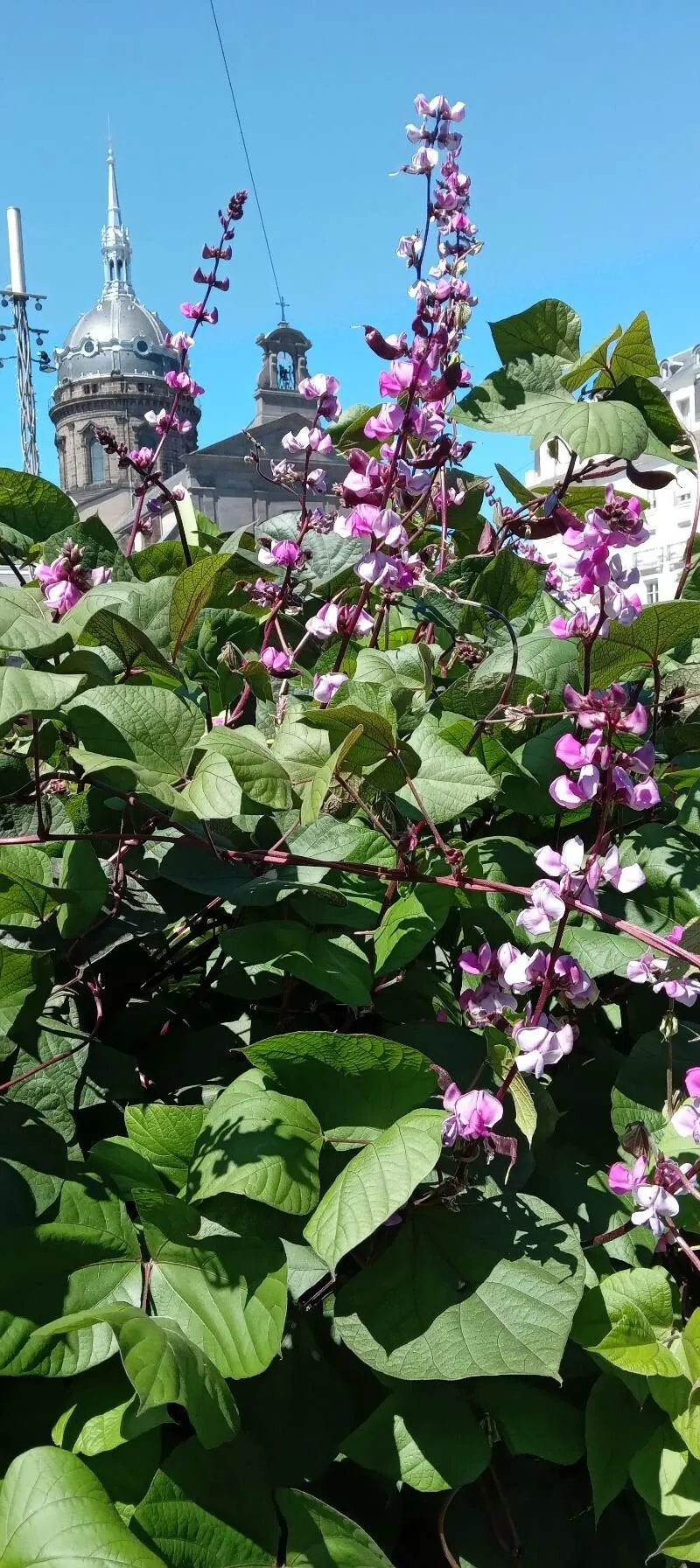
Author: Sweet (L.)
Bibliography: Hort. brit. ed. 1:481. 1826
Year: 1826
Status: accepted
Rank: species
Genus: Lablab
Vegetable: True
Observations: Cape Verde, Trop. & S. Africa, Madagascar, India
The Lablab-bean, scientifically named Lablab purpureus, is a versatile and resilient legume known for its adaptability to various tropical and subtropical climates. First described in 1826 by the renowned botanist Lionel Sweet, this plant holds a significant place in both agriculture and horticulture due to its nutritional and ecological benefits.
The Lablab-bean is indigenous to several regions including Cape Verde, tropical and southern Africa, Madagascar, and India. Its widespread native range highlights its adaptability and resilience under different environmental conditions. Lablab purpureus is a member of the Fabaceae family, which is renowned for its ability to enrich soil fertility through nitrogen fixation—a symbiotic process involving root nodules and nitrogen-fixing bacteria.
This plant is characterized by its robust, climbing vine structure and distinctive purplish or green pods, which are filled with edible seeds. The flowers, often a striking white or purple, are known to attract pollinators, contributing to the ecological health of its growing environment. The leaves are trifoliate, comprising three heart-shaped leaflets that are not only aesthetically pleasing but also high in nutritional value.
Lablab-bean is cultivated for multiple purposes including as a food source for humans and livestock. The young pods and leaves can be consumed as vegetables, while the dried seeds are often used in soups and stews. In many traditional cuisines, especially in African and Indian diets, Lablab-bean is a staple ingredient known for its rich protein content and essential nutrients.
Aside from its culinary uses, Lablab purpureus is also employed as a cover crop and green manure. Its deep root system helps in soil aeration and the plant’s organic matter improves soil structure and fertility. This makes it an excellent choice for sustainable farming practices, particularly in regions experiencing soil erosion and nutrient depletion.
In traditional medicine, various parts of the Lablab-bean plant are used to treat ailments, reflecting its cultural significance across its native and cultivated regions. Research is ongoing to further understand the medicinal properties and health benefits associated with this versatile legume.
In summary, the Lablab-bean is not just a plant of agricultural importance but also holds ecological and cultural significance. Its ability to thrive in diverse climates, coupled with its nutritional and soil-enhancing properties, makes Lablab purpureus an invaluable species within the Fabaceae family.
Eng: hyacinthbean, hyacinth-bean, lablab-bean, hyacinth bean, black bean, bonavist, bonavist-bean
Ita: fagiolo d’egitto
Swe: hjälmböna
Fra: dolique d’égypte
En: Lablab-bean, Hyacinth-bean, Hyacinthbean, Hyacinth Bean, Japanese Delchos, Black bean, Bonavist, Bonavist-bean, Antaque, Banner Bean, Bonavist Bean, Carmelita, Frijol Caballero, Lablab Bean, Natoba, Northern Buckler-fern, Sweet Pea
Ar: لبلب, Lablab, Lubiah
Ca: Mongeta egípcia
Zh: Bian dou, 扁豆, 鵲豆
Da: Hjaelbønne, Hjelmbønne
Fi: Hyasinttipapu
Fr: Pois Blanc, Dolique d’Égypte, Antaque rouge, Lablab, Lablab pourpre, Haricot
De: Helmbohne, Faselbohne
Gu: વાલ
He: שעועית יקינתון
Hu: Bivalyvborsó
Id: Kara
It: Fagiolo d’Egitto
Kn: ಅವರೆ
Kk: Сүмбіл бұршақ
Ko: 편두
Ml: അമര
Mr: वाल
Ne: टाटे सिमी
No: Hjelmbønne
Or: ଶିମ୍ବ
Fa: لبلب
Pt: Feijão cutelinho
Ru: Лобия
Sg: Gbundo
Sd: سيم
Es: Frijol caballero negro, Haba, Chícharos, Bona wiss, Frijol Caballero, Habas de caballo
Sw: Mfiwi mafuta
Sv: Hjälmböna, Hjälmbönssläktet
Tl: Bitsuwelas
Zh-tw: 鵲豆
Ta: அவரை Avarai, அவரை
Te: Chikkudu
Th: ถั่วแปบ
Zh-hant: 扁豆
Tr: Adi misir börülccesi
Vi: Đậu ván
Taken May 4, 2017 by Pierre Bonnet (cc-by-sa)
Taken May 4, 2017 by Pierre Bonnet (cc-by-sa)
Taken May 4, 2017 by Pierre Bonnet (cc-by-sa)
Taken May 4, 2017 by Pierre Bonnet (cc-by-sa)
Taken Oct 21, 2020 by ben vc (cc-by-sa)
Taken Sep 8, 2021 by Mark Novbett (cc-by-sa)
Taken Aug 7, 2022 by Fabrice Rubio (cc-by-sa)
Taken Dec 12, 2019 by Dieter Albrecht (cc-by-sa)
Taken Dec 3, 2021 by Arthur cooke (cc-by-sa)
Taken Jul 3, 2019 by Anise saffnee (cc-by-sa)
Taken Jan 9, 2022 by Sébastien TRASBOT (cc-by-sa)
Taken May 4, 2017 by Pierre Bonnet (cc-by-sa)
Taken May 4, 2017 by Pierre Bonnet (cc-by-sa)
Taken Aug 7, 2022 by Fabrice Rubio (cc-by-sa)
Taken Dec 12, 2019 by Dieter Albrecht (cc-by-sa)
© copyright of the Board of Trustees of the Royal Botanic Gardens, Kew.
© copyright of the Board of Trustees of the Royal Botanic Gardens, Kew.
© copyright of the Board of Trustees of the Royal Botanic Gardens, Kew.
Taken Dec 12, 2019 by Dieter Albrecht (cc-by-sa)
Taken Dec 12, 2019 by Dieter Albrecht (cc-by-sa)
Taken Dec 12, 2019 by Dieter Albrecht (cc-by-sa)
Taken Dec 12, 2019 by Dieter Albrecht (cc-by-sa)
Taken May 4, 2017 by Pierre Bonnet (cc-by-sa)
Taken Aug 28, 2022 by Stev Reba (cc-by-sa)
Taken Dec 7, 2021 by Sébastien TRASBOT (cc-by-sa)
Taken Nov 6, 2022 by Fabrice Rubio (cc-by-sa)
Taken Oct 10, 2022 by Steve Archer II (cc-by-sa)
Taken Dec 12, 2019 by Dieter Albrecht (cc-by-sa)
Taken Sep 20, 2022 by tomhuck88 (cc-by-sa)
Taken Apr 23, 2020 by JP Corrêa Carvalho (cc-by-sa)
Taken Apr 7, 2021 by Veronika Thieme (cc-by-sa)
Taken May 4, 2017 by Pierre Bonnet (cc-by-sa)
Growth form: Single Stem
Growth habit: Vine, Forb/herb
Growth rate: Rapid
Ph maximum: 7.8
Ph minimum: 4.5
Family: Myrtaceae Author: (F.Muell.) K.D.Hill & L.A.S.Johnson Bibliography: Telopea 6: 402 (1995) Year: 1995 Status:…
Family: Rubiaceae Author: Pierre ex A.Froehner Bibliography: Notizbl. Bot. Gart. Berlin-Dahlem 1: 237 (1897) Year:…
Family: Sapindaceae Author: Koidz. Bibliography: J. Coll. Sci. Imp. Univ. Tokyo 32(1): 38 (1911) Year:…
Family: Asteraceae Author: A.Gray Bibliography: Pacif. Railr. Rep.: 107 (1857) Year: 1857 Status: accepted Rank:…
Family: Fabaceae Author: Medik. Bibliography: Vorles. Churpfälz. Phys.-Ökon. Ges. 2: 398 (1787) Year: 1787 Status:…
Family: Aspleniaceae Author: (Cav.) Alston Bibliography: Bull. Misc. Inform. Kew 1932: 309 (1932) Year: 1932…